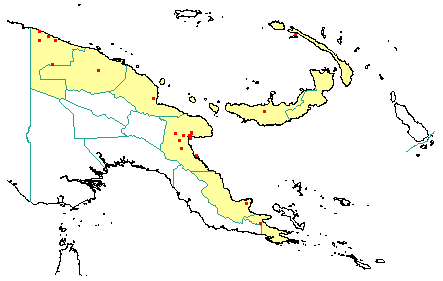
in PNGplants database
PNGTreesKey – Maniltoa schefferi K.Schum. |
Barry Conn (NSW) & Kipiro Damas (LAE).
Guide to trees of Papua New Guinea
Copyright held by the authors, National Herbarium of New South Wales, and Papua New Guinea National Herbarium
Die Flora von Kaiser Wilhelms Land 101 (1889)
Other Literature: B. Verdcourt, A Manual of New Guinea Legumes 70-71 (1979) Fig. 16-17.
Family: Fabaceae
Dicotyledon
Timber Group: Minor hardwood
Field Characters: Large canopy tree or Small sub-canopy tree; Bole cylindrical; straight; buttresses buttresses present; spines spines absent; aerial roots aerial roots absent; stilt roots stilt roots absent; Bark grey or brown, rough, pustular, lenticels rounded/swelling; Subrhytidome (under-bark) red; less than 25 mm thick, 10.0-12.0; bark blaze consisting of one layer; faintly to non-aromatic; outer blaze pink to brown, with stripes (red-brown); inner blaze pink to brown, with stripes (red-brown); bark exudate (sap) present, red to brown, not readily flowing (spotty), colour not changing on exposure to air, not sticky; terminal buds not enclosed by leaves.
Indumentum: Complex hairs absent; stinging hairs absent; mature twig indumentum (hairs) absent.
Leaves: Leaves spaced along branches, spiral (leaves occurring singly at a node and arranged spirally up the branchlet), compound (a leaf made up from two or more leaflets); petiole present, not winged, attached to base of leaf blade, not swollen; leaves rarely with one leaflet or with two leaflets to pinnate (unbranched with more than three leaflets); petiolule swollen; rachis present, absent, absent; leaves without a terminal leaflet (the number of leaflets even - paripinnate), broadest at or near middle to broadest below middle to equally broad throughout much of length, 7.0-18.0 (-20.0) cm, 3.0-8.5 (-10.0) cm, leaflets opposite, asymmetric (slightly (midvein usually closer to upper margin); venation pinnate, secondary veins open, prominent, intramarginal veins absent; leaves lower surface green, upper surface dark green, indumentum (hairs) absent; absent; domatia absent; stipules present, free, laterally placed, not encircling the twig, leafy, not fringed, large, not persistent.
Flowers: Inflorescence axillary, flowers arising from a single point to flowers on an unbranched axis (axis reduced), cones absent; flowers bisexual, stalked, flowers with many planes of symmetry, 8.0-11.0 mm long, diameter small (up to10 mm diam.) to diameter large (more than10 mm diam.); perianth present, with distinct sepals and petals whorls, inner perianth white or pale pink; 5, free; stamens 30-35, present, joined, free of the perianth; ovary superior, carpels joined (when more than one), locules 1; styles solitary, 1.
Fruits: Infrutescence arising from single point or arranged on unbranched axis, fruit 2.5-3.5 mm long, brown, not spiny, non-fleshy, simple, indehiscent, drupe; seeds 1 (-2), much more than 10 mm long, not winged, broad (as wide as long), seed 1-10 mm diam.
Distribution: West Sepik, East Sepik, Madang, Morobe, Northern, Milne Bay, New Britain & New Ireland.
 | Botanical records in PNGplants database |
Notes: Notes This species is classified in Fabaceae subfamily Caesalpinoideae.